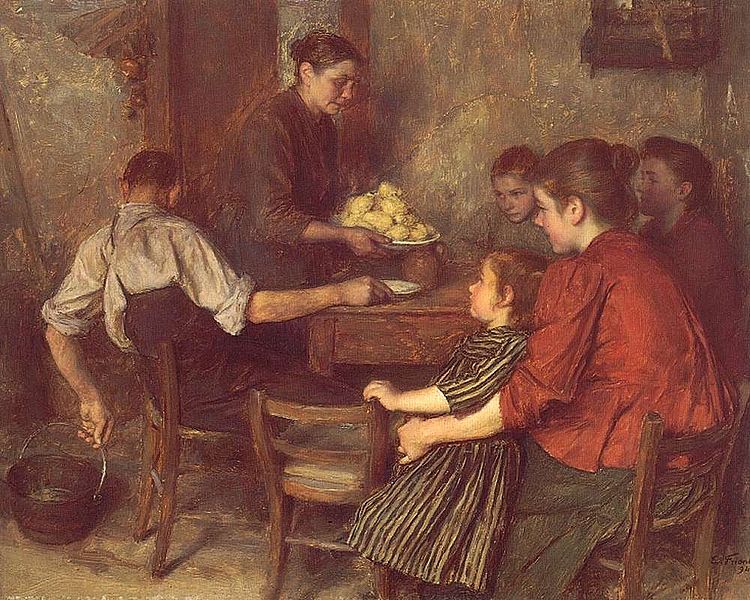
(Wikimedia Commons public domain image)
Jenet Jacob Erickson , who earned her doctorate in family social science from the University of Minnesota, is an associate professor in religious education at Brigham Young University, where she teaches the Eternal Family (Rel 200) course and the Introduction to Family Process (SFL 160) course for the School of Family Life. She is a research fellow of both the Wheatley Institute and the Institute for Family Studies and has been a columnist on family issues for the Deseret News since 2013. She also grew up not far from my house and indeed, for a time, several ward boundaries ago, in our ward.
Dr. Erickson has recently published a solid summation of data in support of a notion that once seemed obvious and natural but is now very countercultural: “It Takes Two: What We Learn from Social Science about the Divine Pattern of Gender Complementarity in Parenting.”
Making no claim that what I’ve selected is representative of her overall argument, I share with you some of the passages in her article that I marked as I read it:
Professor Erickson insightfully describes the Genesis creation narrative as proceeding
through a series of differentiations and separations (Gen. 1:1). We find his holy ordering in the separation and complementarity of heaven and earth, light and dark, day and night, morning and evening, clouds and seas, water and dry land. . . .
At Creation’s pinnacle, we are presented with the differentiation of male and female, wholly distinct and complementary, each bearing the image of God, imago Dei. “In the beginning,” we learn that eternity is composed of a holy ordering of complementary realities, culminating in male and female, in whose union we see the eternal God. (6)
I had forgotten this wonderful passage from Elder Erastus Snow, who served in the Council of the Twelve Apostles from 1849 until his death in 1888:
There can be no God except he is composed of the man and woman united, and there is not in all the eternities that exist, nor ever will be, a God in any other way. I have another description: There never was a God, and there never will be in all eternities, except they are made of these two component parts; a man and a woman; the male and the female. (cited on page s6)
I also like this passage from my late friend Elder Bruce D. Porter, of the Seventy, which I had forgotten: The eternal reality of male and female, he said, is “woven into the fabric of the universe, a vital, foundational element of eternal life and divine nature” (cited on page 6).
So much, though, for the doctrinal background. Here are some findings from social science:
[N]ot all mothers and fathers are going to parent in the ways these studies found to be typical. What does appear to be clear is that even if a mother or father does not parent in a way that appears to be “consistent” with typical patterns, in the process of parenting together a mother and a father tend to take complementary approaches, almost with an intuitive sense that children need the difference between them, even if that difference is not typical of others. (9)
Neither the father nor the mother is subordinate to each other. Rather, their intertwining differences reveal a complementarity that is measurably significant in facilitating healthy development. (11)
“For boys, the mere presence of a father in the home predicts less delinquent behavior.” (17)
This was certainly true in my household, with my children, for good or for ill:
As one report noted, “rough-housing with dad” appears to “teach children how to deal with aggressive impulses and physical contact without losing control of their emotions.” Through play, fathers help children learn how to temper and channel emotions in a positive, interactive way and gain confidence in their ability to do so. As children age, fathers focus less on physical play and engage in more peer-like verbal play in the form of sarcasm and humor. Peer-like verbal play allows a father to tease and joke with a child within the safety of the father-child relationship, thus strengthening children’s sense of identity and social confidence. (18)
And now for a few more passages that I marked:
Fathers also appear to play an important role in academic achievement. An involved father has been identified as the strongest predictor of college graduation. Children with involved fathers were 42 percent more likely to earn “A” grades, 33 percent less likely to repeat a grade, and 98 percent more likely to graduate from college. (20)
While evidence clearly suggests that fathers and mothers each shape children’s social-emotional and mental development in different ways, evidence also suggests that the mere presence of gender differences is itself important to development—particularly in specific psychological capacities and sexual development. . . .
Fathering scholar Rob Palkovitz draws on findings from researchers in France (as well as developmental scholar Danielle Paquette) in explaining that even though less differentiated parenting appears to be “more socially desirable” today, there is considerable evidence that “the family structure that is most favorable to the socioaffective development of young children” is one in which parents reflect the “different styles, voices, histories, and connections” of distinct maternal and paternal patterns.
Children benefit from “discrimination learning in the positive sense, the formulation of and analyses of differences,” as they experience the psychological and physical differences between their two parents. Thus, Palkovitz concludes, “Experiencing parental differences affords children the opportunity to develop nuanced understandings of individual differences in personality as well as gender, enhancing social cognition . . . [and] advanced cognitive functioning.” . . .
The experience of both a parent who is opposite sex and a parent who is of the same sex thus plays an important role in facilitating a child’s ability to understand his or her own gender identity. (22-23)
The Fourth National Incidence Study of Child Abuse and Neglect Report to Congress found that children raised by their married mothers and fathers were the least likely to experience abuse. Children living with their single mother and unrelated boyfriend were ten times more likely to be abused when compared to children living with their married mother and father. These findings are consistent with the National Survey of Children’s Health reporting on the percentage of children who experience adverse childhood events (ACEs). ACEs have become increasingly important to identify because they represent traumatic experiences that can have negative, lasting effects on health and well-being across development. Children living in families with their married biological parents were overwhelmingly safer than children living with just one biological parent, or with nonparental caregivers. While 70 percent of children living with both biological parents never experienced an adverse childhood event, 78 percent of those living with just one biological parent had experienced at least one of them. (25-26)
Both a father and a mother are needed to create life, and . . . both are needed to best facilitate the nurturing of that life. (5)
Dr. Erickson closes with a wonderful passage from Elder Bruce C. Hafen and Sister Marie K. Hafen:
In the . . . family, each spouse freely gives something the other does not have and without which neither can be complete and return to God’s presence. Spouses are not a soloist with an accompanist, nor are they two solos. They are the interdependent parts of a duet, singing together in harmony at a level where no solo can go. (cited on page 27)
And, finally, this fact simply amazed me:
Remarkably, an estimated one million new synapses are forming each second, leading to a literal doubling in brain size during the first year and a half of life. And most of it happens within a very specific section of the brain, the right brain, where personality, self-awareness, empathy, capacity for attention, regulation of stress, ability to experience and read emotions, and capacity for intimacy are developed. (12)
I recommend Professor Erickson’s entire article to you as a good defense of the teaching of the Church of Jesus Christ of Latter-day Saints that “marriage between a man and a woman is ordained of God and that the family is central to the Creator’s plan for the eternal destiny of His children.” When the Proclamation on the Family, from which that quotation comes, first appeared, I was not alone in thinking that, well, it wasn’t exactly earth-shattering — and certainly not within the Church or among the Saints — but was pretty commonsensical and obvious. Thus demonstrating pretty clearly why I am not one of those who have been sustained by the membership of the Church as prophets, seers, and revelators.
Posted from Victoria, British Columbia













